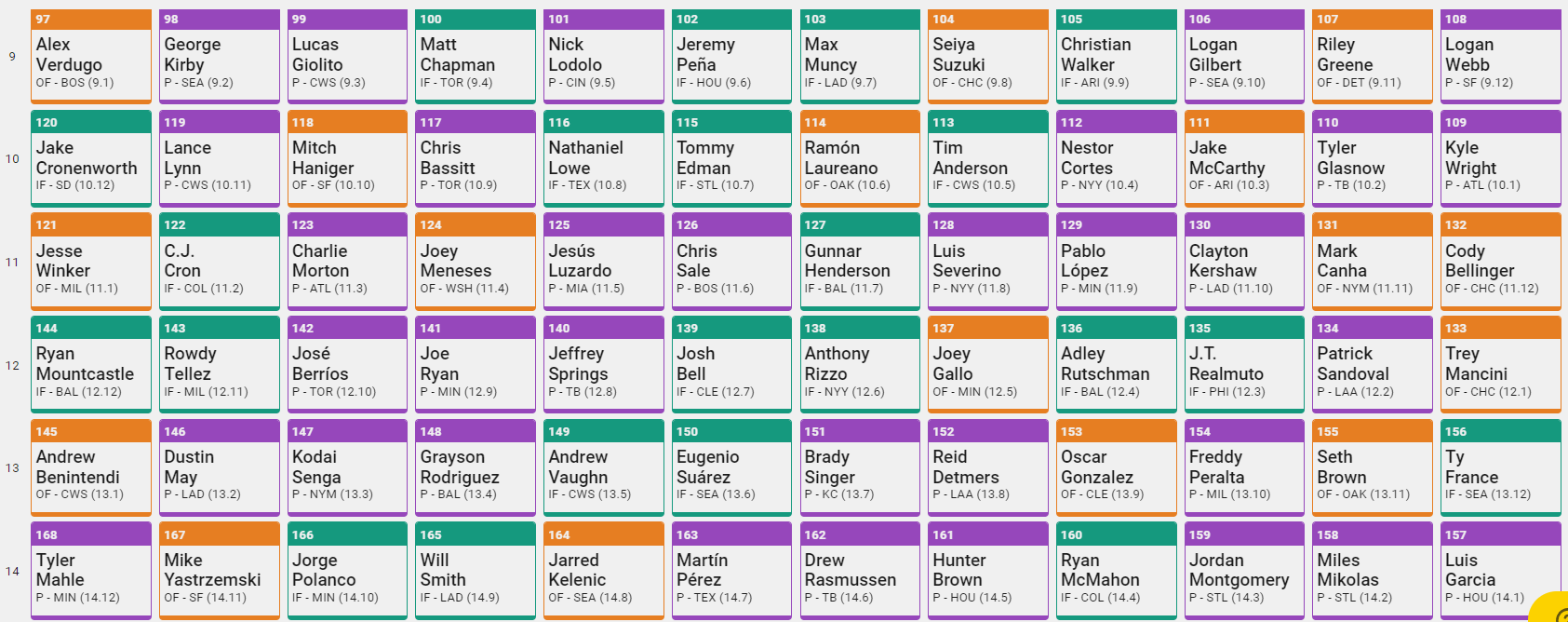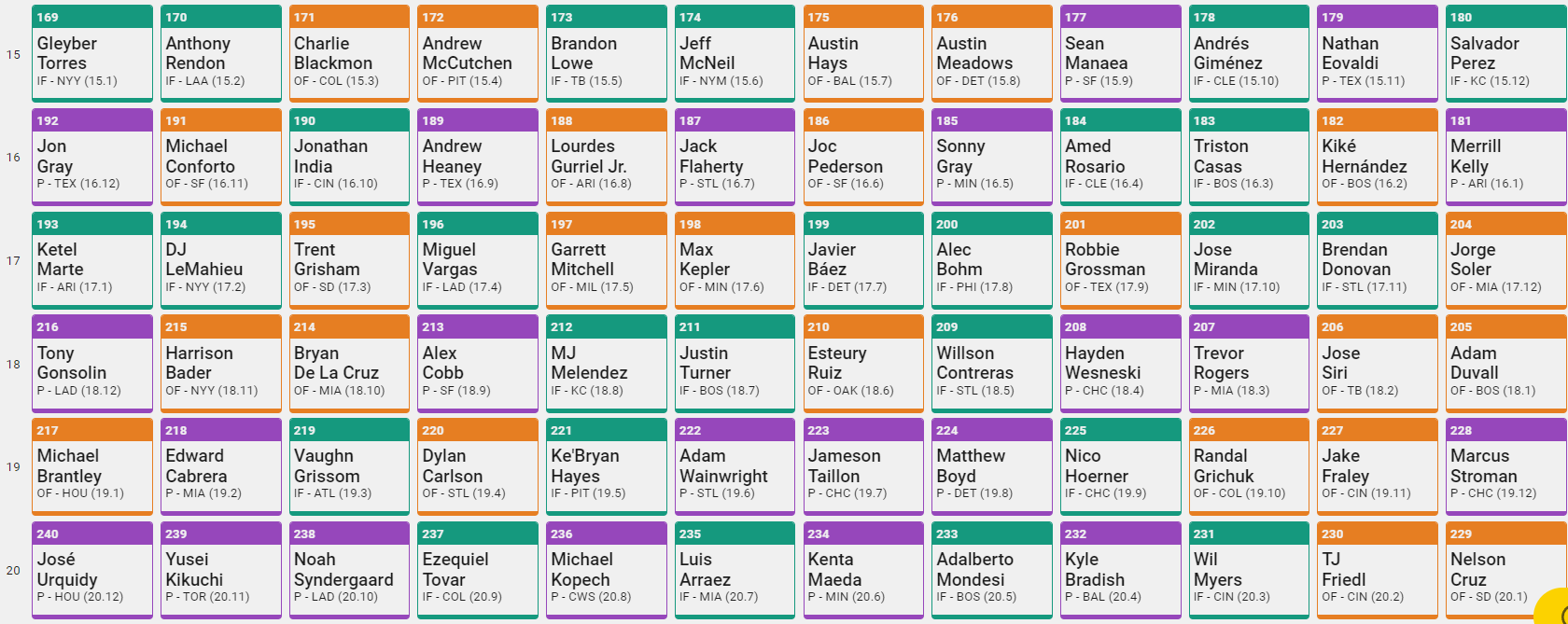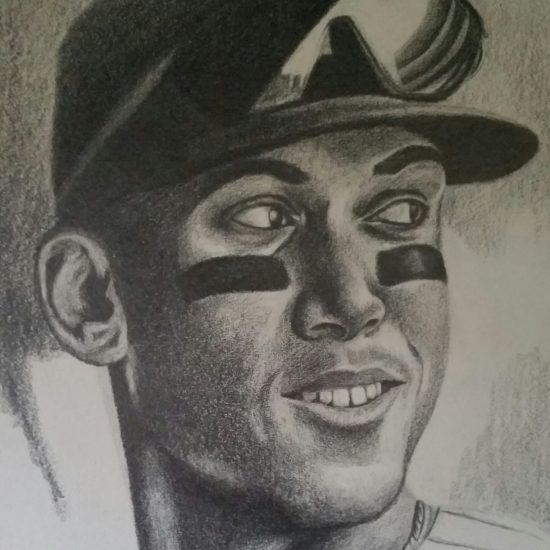This is a sponsored post from Underdog Fantasy. Sign up today with promo code PITCHERLIST to get 100% of your deposit matched up to $100.
If you’re unfamiliar with Best Ball, it’s a fun format. One of the many contests offered on Underdog, Best Ball is somewhere in between DFS and season-long in that you’re not drafting a new team every day, and you don’t have to agonize over starts and sits. It’s a great format if you’d rather not commit to managing a season-long team, yet still find yourself eager to draft a roster. There’s no waiver wire or injured list to manage. Once you draft your team, you’re done- that’s it.
Scoring
Rosters consist of three IF, three OF, one FLEX, three pitchers, and ten bench players. In Best Ball, your highest-scoring roster is tallied every week. Everything is added up at the end of the season, with the top three teams winning money.
Note that Underdog does have projections listed for every player, but here I’ll refer to the projections on Pitcher List.
Rounds 1-3

I drew the first pick and chose Aaron Judge. Pitcher List projections have him with a nominal edge over Juan Soto, to the point where there’s merit in selecting Soto first overall if you’re trying to differentiate with multiple teams.
In the second and third, I went back-to-back with Matt Olson and Sandy Alcantara. It could be a mistake, but I find myself fading last year’s NL Cy Young Award winner in standard season-long leagues. In this format, he’s hard to ignore simply because of the innings pitched (IP).
I liked Team 12’s pick of Jacob deGrom to end the third round. The projections have him behind the other big aces, but that’s a product of trying to guess his total IP. If he goes over the 140 IP projection, then he could really set himself apart. As the ninth pitcher off the board, he’s a boom/bust play that makes sense in this format. I would have really loved Team 12’s start if they had gone with Kyle Schwarber instead of Pete Alonso. As you might recall from last week, one of the things that stuck out was how quickly the OF pool shrinks.
Team 2 started with Soto, Manny Machado, and Bo Bichette, and came out of the third round leading the pack by about 200 points. The other two teams that avoided taking a pitcher, 5 and 7, ended the third round projected second and third, respectively, in total points.
Rounds 4-8

I completely understand the hype for Corbin Carroll in standard formats with his breathtaking speed. But as the first pick of Round 4, he seemed like a little bit of a reach in this format. George Springer, Teoscar Hernández, Christian Yelich, and Cedric Mullins were all projected ahead of Carroll by over 100 points.
Speaking of Hernández, Nick Pollack (Team 7) selected him in the middle of the fifth, and that looked like a good value relative to the next outfielder taken, Kris Bryant, with about 100 points difference between the two.
Bryce Harper went in the middle of the sixth round, just about a round before he was taken in our draft last week.
I ended the sixth by taking Taylor Ward as my second OF. Despite the mid-season drought, he still finished 22nd among qualifiers with a .360 OBP and should score well in this format as the Angels’ leadoff hitter.
I think if I were Team 12, I’d have wanted a mulligan with how Rounds 6 and 7 turned out. Instead of Oneil Cruz as a third IF in Round 6, Christian Yelich might have been a better fit as a second OF, seeing as Vinnie Pasquantino was there in Round 7. Of course, there’s no way they could have known that would happen, this is only me playing Monday morning QB.
In last week’s article, I mentioned the idea of taking two arms in the first five rounds and then filling your rotation very late. That could work, but I think a better plan is aiming for three pitchers in the top nine rounds (i.e. the top 30 SPs or so). I ended up with Zac Gallen as the first pick in Round 7 and was slightly disappointed because I was hoping for either Julio Urías, Carlos Rodón, or Zack Wheeler. If I did that over, I’d have taken Tyler O’Neill, because his volatility is well-suited for Best Ball. And then I would’ve gone with George Kirby in Round 9 instead of Alex Verdugo.
Nick Pollack scooped Joe Musgrove in the middle of Round 8, a potential steal provided the righty returns from his injury quicker than initially thought. Last year, Musgrove finished tied for sixth with 23 QS. Nick’s team finished Round 8 with about a 200-point lead in total projected points.
Rounds 9-14

Knowing how volatile hitters are I wanted to stack as many at-bats as I could, so I continued with Alex Verdugo in the ninth. I led off the 11th round with Jesse Winker. I like him as a bounceback candidate and figured he might have some big weeks against RHP.
Some interesting arms went in the 13th round. If I played this draft out again, I might have replaced Andrew Benintendi with either Dustin May or Freddy Peralta, who is a perfect mystery box pitcher for Best Ball.
Instead, I ended up being one of the last teams to take a fourth pitcher and went with Tyler Mahle to close the 14th. My thinking is that it’s just easier to find innings later in the draft because some of the bats in the final few rounds seem more difficult to project in terms of playing time.
Team 8 had a very unique strategy and actually didn’t take a third pitcher until Reid Detmers in the 13th.
Rounds 15-20

Miguel Vargas, 17.4, and Nico Hoerner, 19.8, looked like great values in terms of guaranteed at-bats. Harrison Bader, 18.11, was another bat that stood out as a potential late-round bargain, provided he recovers from his oblique injury.
Adam Duvall and Charlie Blackmon are veterans on teams that shouldn’t be competitive, so I don’t think it would be surprising to see them lose at-bats in the second half of the season. Robbie Grossman is another bat who I’d want to avoid here as he looks to be in a platoon role in Texas.
Jake Fraley carries at least a little uncertainty as far as playing time goes. He has categorical upside in standard leagues, but for me, he’s someone who I’d rather have on a managed roster than in Best Ball because of the downside in playing time which might make him dead weight here. The same goes for his teammate TJ Friedl. Though I suppose the counterpoint is that the uncertainty in playing time makes them good dice rolls here. That’s the fun part about Best Ball. There are different ways to approach it.
I’ve found myself drifting toward pitching in the last three rounds, as that’s where you can find some steady sources of innings. Tony Gonsolin won’t be ready for Opening Day, but in the 18th round, he looked like a decent buy-low, provided his IL stint isn’t too long. Marcus Stroman, Jameson Taillon, Michael Kopech, Alex Cobb, Kenta Maeda, and Trevor Rogers all looked like excellent options in the last three rounds. Cobb is one of my favorites, as he’s reportedly added a slider to his pitch mix, but he went three spots ahead of me in Round 18.
Team 2 closed with Edward Cabrera and Yusei Kikuchi. They have strikeout upside, but I’m inclined to fade them in this format due to their inefficiency; I’m not convinced either one are good bets for quality starts. My last pick was José Urquidy. Although he doesn’t have strikeout upside, his efficiency provides value in wins, quality starts, and innings.

